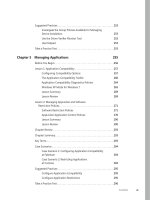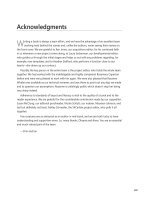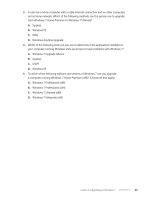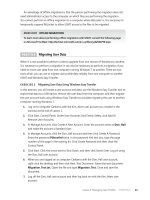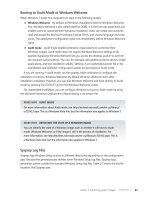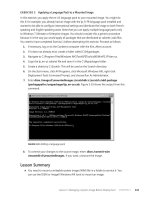Configuring Windows 7 (Training Kit) - Part 11 pdf
Bạn đang xem bản rút gọn của tài liệu. Xem và tải ngay bản đầy đủ của tài liệu tại đây (257.32 KB, 10 trang )
Lesson 1: Capturing System Images CHAPTER 2 73
Using MDT 2010
MDT 2010 is the Microsoft solution accelerator for operating system and application
deployment and offers flexible driver management, optimized transaction processing,
and access to distribution shares from any location. You can use the MDT on imaging and
deployment servers to implement the automatic deployment of Windows 7 (for example)
on client computers. It is possible to run MDT 2010 on a client running Windows 7, but in
practice it would typically run from a distribution server running Windows Server 2008.
The MDT provides detailed guidance and job aids and offers a common deployment
console that contains unified tools and processes that you can use for client and server
deployment. The toolkit offers standardized desktop and server images, along with improved
security and ongoing configuration management.
The Lite Touch Installation (LTI) method lets you distribute images with a small degree of
user intervention and can be used when no other distribution tools are in place. Most of the
new features in MDT 2010 are related to LTI.
The Zero Touch Installation (ZTI) method requires no user intervention but requires that
Microsoft System Center Configuration Manager (SCCM) 2007 with the Operating System
Deployment Feature Pack is available on the network. This method also requires other
software utilities, such as Microsoft SQL Server.
note SYSTEM MANAGEMENT SERVER (SMS) 2003
MTD 2010 ZTI does not work with SMS 2003.
When you have installed MDT 2010, you can start Deployment Workbench from the
Microsoft Deployment Toolkit program suite. This gives you access to the following items:
n
Information Center This lets you access MDT 2010 documentation.
n
Distribution Share This gives you a checklist of tasks you need to perform before you
can deploy an operating system. You can also create a distribution share directory.
n
Task Sequences This provides a list of task sequences in the details pane and enables
you to create and configure a task sequence.
n
Deploy You can expand this item to see the Deployment Points and Database items.
You can configure deployment points and the MDT database.
More Info MDT 2010
To download MDT documentation files (without necessarily installing the software), go to
and click Download.
74 CHAPTER 2 Configuring System Images
WDS Images
WDS provides a PXE-booted version of Windows PE. A WDS image is contained in a WIM
file and is booted over the network into a RAMDisk. The installation then proceeds under
Windows PE.
WDS integrates into Active Directory Domain Services (AD DS), but the PXE server can
also run without AD DS if required. WDS can be initiated from Windows PE booted from
something other than PXE, such as a CD/DVD-ROM or UFD.
The process of capturing a WIM image into a WDS server is similar to the use of ImageX
and Sysprep except that the last step involves booting into the WDS capture image. This is
a Windows PE image that helps you capture a client system to the WDS server.
WDS is relatively lightweight compared to other image deployment methods such as MDT
and provides a method that can be faster than an optical media-based installation of Windows.
You use WDS images to deploy system files to client computers. A number of image files
exist; for example, you use a capture image to create an install image. You should be familiar
with the following image types:
n
Install
n
Boot
n
Capture
n
Discover
An install image is an operating system image that you deploy to the client computer.
Typically, this is a WIM file.
A boot image is a Windows PE image into which you boot a client before you install the
WIM image file. To install Windows 7, you first boot the computer into the boot image, and
then you select the install image to install. Unless you are using a reference computer and
adding applications to the image, you should use the standard boot image that is included on
the Windows 7 installation media (Install.wim). Capture and discover images are types of boot
images.
A capture image is a type of boot image into which you boot a client computer to capture
the operating system as a WIM install image file. You create a capture image before you
create a custom install image. A capture image contains Windows PE and the Windows
Deployment Services Image Capture Wizard. When you boot a computer (after preparing
it with Sysprep) into a capture image, the wizard creates an install image of the computer
and saves it as a WIM file. Then you can upload the image to the WDS server or copy it to
bootable media (for example, DVD-ROM).
A discover image is a type of boot image that you can use to install Windows 7 (or another
Windows operating system) on a computer that is not PXE-enabled. When you boot
a computer into a discover image, the WDS client locates a valid WDS server, and then you
can choose the install image you want to install. A discover image enables a computer to
locate a WDS server and use it to install an image.
Lesson 1: Capturing System Images CHAPTER 2 75
More Info CREATING IMAGES
For more information about creating images, see
library/cc730907.aspx. This is a Windows Server 2008 link because WDS is a server role and
cannot be installed on a client computer.
Using the Deployment Image Servicing
and Management Tool
Windows 7 introduces the DISM command-line tool. Chapter 3 discusses this tool in some
detail, so it is introduced only briefly here. You can use DISM to service a Windows image or
to prepare a Windows PE image. DISM replaces Package Manager (Pkgmgr.exe), PEimg, and
Intlcfg in Windows Vista, and includes new features to improve the experience for offline
servicing.
You can use DISM to perform the following actions:
n
Prepare a Windows PE image.
n
Enable or disable Windows features within an image.
n
Upgrade a Windows image to a different edition.
n
Add, remove, and enumerate packages.
n
Add, remove, and enumerate drivers.
n
Apply changes based on the offline servicing section of an unattended answer file.
n
Configure international settings.
n
Implement powerful logging features.
n
Service operating systems such as Windows Vista with SP1 and Windows Server 2008.
n
Service a 32-bit image from a 64-bit host and service a 64-bit image from a 32-bit host.
n
Service all platforms (32-bit, 64-bit, and Itanium).
n
Use existing Package Manager scripts.
DISM Command-Line Options
To service a Windows image offline, you must apply or mount it. WIM images can be
mounted using the WIM commands within DISM, or applied and then recaptured using
ImageX. You can also use the WIM commands to list the indexes or verify the architecture
for the image you are mounting. After you update the image, you must dismount it and then
either commit or discard the changes you have made.
Table 2-4 lists and describes the dism command options that you can use to mount,
dismount, and query WIM files, as well as their associated flags. These options and flags are
not case-sensitive.
76 CHAPTER 2 Configuring System Images
TABLE 2-4 DISM Command Options
OPTION DESCRIPTION FLAGS
/mount-wim Mounts the WIM file to the specified
directory so that it is available for
servicing. The optional /readonly flag
sets the mounted image with read-
only permissions.
Example: dism /mount-wim
/wimfile:C:\practice\myimages\
install.wim /index:1 /mountdir:
C:\practice\offline /readonly
/wimfile:<path_to_
image.wim>
/index:<image_index>
/name:<image_name>
/mountdir:<path_to_mount_
directory>
/readonly
/commit-wim Applies the changes you have made
to the mounted image. The image
remains mounted until the /dismount
option is used.
Example: dism /commit-wim
/mountdir:C:\practice\offline
/mountdir:<path_to_mount_
directory>
/unmount-wim Dismounts the WIM file and either
commits or discards the changes
that were made while the image was
mounted.
Example: dism /unmount-wim
/mountdir:C:\practice\offline /commit
/mountdir:<path_to_mount_
directory>{/commit | /
discard}
/remount-wim Recovers an orphaned WIM mount
directory.
Example: dism /remount-wim
/mountdir:<path_to_mount_directory>
/mountdir:<path_to_mount_
directory>
/cleanup-wim Deletes all the resources associated
with a mounted WIM image that has
been abandoned. This command
does not dismount currently mounted
images, nor does it delete images that
can be remounted.
Example: dism /cleanup-wim
None
/get-wiminfo Displays information about the images
within the WIM. When used with the
/index option, information about the
specified image is displayed.
Example: dism /get-wimInfo /wimfile:
C:\practice\offline\install.wim /index:1
/wimfile:<path_to_image.
wim>
/index:<Image_index>
/name:<Image_name>
Lesson 1: Capturing System Images CHAPTER 2 77
OPTION DESCRIPTION FLAGS
/get-
mountedwiminfo
Lists the images that are currently
mounted and information about the
mounted image such as read/write
permissions, mount location, mounted
file path, mounted image index.
Example: dism /get-mountedwimInfo
/name:<image_name>
/mountdir:<path_to_mount_
directory>
/readonly
DISM Syntax
DISM commands have a base syntax that is very similar from command to command. After
you mount your Windows image, you can specify DISM options, the servicing command
that will update your image, and the location of the mounted image. You can use only one
servicing command per command line. If you are servicing a running computer, you can use
the /online option instead of specifying the location of the mounted Windows image.
The syntax for DISM is as follows:
DISM.exe {/image:<path_to_image> | /online} [dism_options] {servicing_command}
[<servicing_argument>]
eXaM tIP
You use DISM to manipulate existing images. You cannot use the tool to capture new
operating system images.
Using Sysprep to Prepare a Windows 7 Installation
You use the Sysprep command-line tool to prepare an installation of Windows for imaging or
delivery to a user. Sysprep /generalize and sysprep /oobe were mentioned earlier in this lesson.
Sysprep is a powerful tool that includes the Sysprep executable (Sysprep.exe) located in the
%WINDIR%\System32\Sysprep directory. Sysprep.exe first verifies that Sysprep can run. You
can run Sysprep only as an administrator, and only one instance of Sysprep can run at any
given time. Also, the version of Sysprep differs with each version of Windows. Sysprep must
run on the version of Windows with which it was installed.
Sysprep.exe calls other executable files that prepare the Windows installation. The Sysprep
process initializes logging and parses any command-line arguments provided. If no command-
line arguments are provided, the Sysprep window appears. This lets you specify Sysprep actions.
Sysprep processes these actions and calls the appropriate .dll and executable files. It adds the
actions to the log file.
When all tasks are processed, Sysprep either shuts down and restarts the system, or exits.
78 CHAPTER 2 Configuring System Images
Sysprep Command-Line Options
If you have experience with Windows Vista, you will find the sysprep command-line options
for Windows 7 very similar. These are described in Table 2-5.
TABLE 2-5 Sysprep Command-Line Options
OPTION DESCRIPTION
/audit Restarts the computer in Audit mode rather than Windows
Welcome mode. Audit mode lets you add additional drivers or
applications to Windows 7. You can also test an installation of
Windows 7 and verify its integrity before it is sent to a user. If you
specify an unattended Windows setup file, the Windows Setup
/audit mode runs the auditSystem and auditUser configuration
passes.
/generalize Prepares the Windows installation to be imaged. If you specify
this option, all unique system information is removed from the
Windows installation. The SID is reset, system restore points are
cleared, and event logs are deleted. The next time the computer
starts, the specialize configuration pass runs. A new SID is created,
and the clock for Windows activation resets (unless the clock has
already been reset three times).
/oobe Restarts the computer in Windows Welcome mode. Windows
Welcome enables users to customize their Windows 7 operating
system, create user accounts, and name the computer. Any
settings in the oobeSystem configuration pass in an answer file are
processed immediately before Windows Welcome starts.
/reboot Restarts the computer. You can use this option to audit the
computer and to verify that the first-run experience operates
c o r r e c t l y .
/shutdown Shuts down the computer after Sysprep completes.
/quiet Runs Sysprep without displaying on-screen confirmation
messages. You can use this option if you want to automate
Sysprep.
/quit Closes Sysprep after the specified commands complete.
/unattend: answerfile Applies settings in an answer file to Windows during unattended
installation. The variable answerfile specifies the path and file
name of the answer file.
If you do not specify a command-line option, Sysprep presents you with the graphical user
interface (GUI) shown in Figure 2-9. This lets you specify a system cleanup action, choose the
generalize option, and specify a shutdown option.
Lesson 1: Capturing System Images CHAPTER 2 79
FIGURE 2-9 The Sysprep GUI
More Info AUDIT MODE
For more information about Audit mode, see />cc722413.aspx.
If you intend to transfer a Windows 7 image to a different computer, you need to run
sysprep /generalize even if the computer has the same hardware configuration. The sysprep
/generalize command removes unique information from your Windows 7 installation. This
enables you to reuse your image on different computers. The next time you boot the
Windows 7 image the specialize configuration pass runs. During this pass, many feature
actions are processed automatically when you boot a Windows 7 image on a new computer.
All methods of moving a Windows 7 image to a new computer, such as through imaging
or hard disk duplication, must be prepared with the sysprep /generalize command. You cannot
move or copy a Windows 7 image to a different computer without running sysprep /generalize.
Configuration Passes
Configuration passes are phases of Windows Setup during which you apply settings to an
unattended installation answer file. Table 2-6 describes the different configuration passes.
TABLE 2-6 Configuration Passes
CONFIGURATION
PASS DESCRIPTION
windowsPE Configures Windows PE options and basic Windows Setup options.
These options can include setting the product key and configuring
a disk. You can use this configuration pass to add drivers to the
Windows PE driver store and to reflect boot-critical drivers required
by Windows PE if you require that drivers for Windows PE access the
local hard disk drive or a network.
80 CHAPTER 2 Configuring System Images
CONFIGURATION
PASS DESCRIPTION
offlineServicing Applies updates to a Windows image. Also applies packages,
including software fixes, language packs, and other security updates.
During this pass, you can add drivers to a Windows image before that
image is installed during Windows Setup.
specialize Creates and applies system-specific information. For example, you
can configure network settings, international settings, and domain
information.
generalize Enables you to minimally configure the sysprep /generalize command
and other Windows settings that must persist on your reference
image. The sysprep /generalize command removes system-specific
information from the image, for example the unique SID and other
hardware-specific settings. The generalize pass runs only if you run
the sysprep /generalize command.
auditSystem Processes unattended Setup settings while Windows is running in
system context before a user logs onto the computer in Audit mode.
The auditSystem pass runs only if you boot to Audit mode.
auditUser Processes unattended Setup settings after a user logs onto the
computer in Audit mode. The auditUser pass runs only if you boot to
Audit mode.
oobeSystem Applies settings to Windows before Windows Welcome starts.
eXaM tIP
Know the Sysprep command-line options and the Windows Setup configuration passes,
and also know when the configuration passes run; for example, generalize runs if you run
the sysprep /generalize command, and auditUser and auditSystem run if you boot to Audit
mode. Remember that you can use several Sysprep switches in the same command. For
example, to generalize an image and specify the boot-up mode you could enter
C:\windows\system32\sysprep\Sysprep.exe /oobe /generalize /shutdown. Also, know
how to boot to Audit mode (Ctrl+Shift+F3), as described later in this lesson.
Sysprep Answer Files
You can use a Sysprep answer file to configure unattended Setup settings. Not all
configuration passes run during Windows Setup—some are available only when you run
Sysprep.exe. For example, the generalize, auditSystem, and auditUser passes are available only
if you run Sysprep.exe. If you add settings to your answer file in these configuration passes,
you need to run Sysprep.exe to apply the settings.
Lesson 1: Capturing System Images CHAPTER 2 81
To apply settings in the auditSystem and auditUser passes, you use the sysprep /audit
command to boot to Audit mode. To apply settings in the generalize pass, you use the
sysprep /generalize command to generalize the Windows image.
If you install Windows using an answer file (for example, Autounattend.xml), that answer
file is cached. When subsequent configuration passes run, settings in the answer file are
applied to the system. Because the answer file is cached, settings in the cached answer file are
applied when you run Sysprep.exe. If you want to use the settings in a different answer file,
you can specify a separate answer file by using the sysprep /unattend:filename option. You
need to ensure your answer file is a .xml file but is not named Autounattend.xml.
You can use the Answer File pane in Windows SIM to create this file and you can edit it
with a text editor such as Microsoft Notepad. Some experienced administrators use a text
editor rather than Windows SIM to create answer files.
More Info CREATING AN ANSWER FILE WITH WINDOWS SIM
For step-by-step instructions that enable you to create an unattended answer file, see
note PERSISTING PLUG AND PLAY DEVICE DRIVERS DURING THE GENERALIZE PASS
You can persist device drivers when you run the sysprep /generalize command by
specifying the PersistentAllDeviceInstalls setting in the Microsoft-Windows-PnPSysprep
feature. During the specialize pass, Plug and Play scans the computer for devices and
installs device drivers for the detected devices. By default, these device drivers are removed
from the system when you generalize the system. If you set PersistAllDeviceInstalls to True
in an answer file, Sysprep does not remove the detected device drivers.
You can view the status of RunSynchronous commands that run during auditUser in Audit
mode. The AuditUI window displays the status for commands and provides visual progress to
indicate that an installation is continuing and not suspended and a visual indication of when
and where failures occur.
If there are RunSynchronous commands in the answer file in the auditUser configuration
pass, a list of the commands are displayed in the AudiUI window in the order specified by
RunSynchronous/RunSynchronousCommand/Order.
All RunSynchronous commands are processed in order. If the command succeeds, then its
related list item is annotated with a green checkmark. If the command fails, then its related
list item is annotated with a red cross. If a reboot is requested, the AuditUI is redisplayed after
the boot, but only unprocessed list items are shown.
If the list of items in the AuditUI exceeds the height of the display, then the list is clipped to
the display and does not scroll. As a result, some items might not be visible.
82 CHAPTER 2 Configuring System Images
Resetting Windows 7 Activation
When you install Windows 7 with a single license product key, you have a 30-day period
during which you must activate the Windows installation. If you do not activate Windows
within this 30-day period, Windows enters Reduced Functionality Mode (RFM). This prevents
you from logging on to the computer until Windows 7 is activated.
When you run the sysprep /generalize command, the activation clock automatically resets.
You can use the sysprep /generalize command to reset Windows a maximum of three times.
After the third time you run the sysprep /generalize command, the activation clock can no
longer be reset.
You can bypass resetting the activation clock by using the SkipRearm setting in the
Microsoft-Windows-Security-Licensing-SLC feature. You can set the value of SkipRearm to
1 in the sysprep /generalize command, which enables you to run the Sysprep utility without
resetting the activation clock.
More Info MICROSOFT-WINDOWS-SECURITY-LICENSING-SLC
For more information about the Microsoft-Windows-Security-Licensing-SLC feature, see
This is a Microsoft Vista link, but
it is also applicable to Windows 7.
For volume licenses, activation clock reset behavior is different depending on the type of
license. Activation can be reset an unlimited number of times for activated Key Management
Service (KMS) clients. For non-activated KMS clients, the activation clock can be reset only up
to three times, the same as a single license.
Microsoft recommends KMS clients to use the sysprep /generalize command where the
value of the SkipRearm setting is equal to 1. After capturing this image, use the sysprep
/generalize command, where the value of the SkipRearm setting is equal to 0.
Microsoft recommends Multiple Activation Keys (MAK) clients to install the MAK immediately
before running sysprep the last time before delivering a client computer to a user.
For OEM Activation licenses, you do not typically require activation. OEM Activation is
available only to royalty OEMs.
Most users can manage activation after receiving their clients running Windows 7.
However, if you prefer, you can activate the software on behalf of your users. After activation,
most users do not need to activate their installation again.
To activate Windows on a client computer, use the unique Product Key from the certificate
of authenticity (COA) label that is affixed to the specific computer, and activate the computer
on behalf of the user. Run the sysprep /oobe command to prepare the computer for delivery
to the user.

